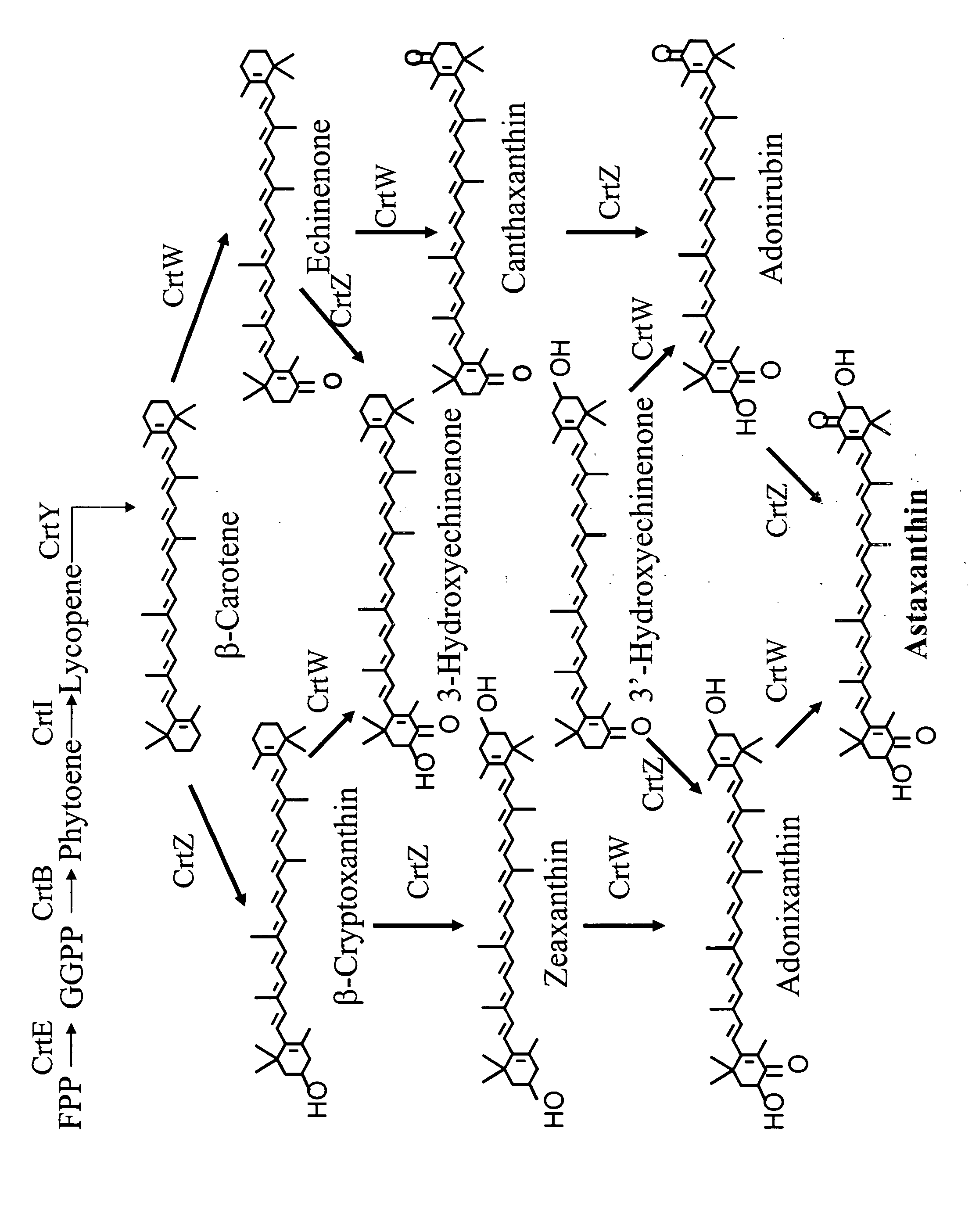Mutant carotenoid ketolases
a technology of carotenoid ketone and mutated nucleic acids, which is applied in the field of microorganisms and molecular biology, can solve the problems of low carotenoid synthesis productivity in these plants, difficult chemically making compounds, and high cost of carotenoids produced by these plants, so as to improve the ability to convert and improve the synthesis activity of astaxanthin
- Summary
- Abstract
- Description
- Claims
- Application Information
AI Technical Summary
Benefits of technology
Problems solved by technology
Method used
Image
Examples
example 1
Sphingomonas melonis DC18 crtW Ketolase
[0197] The isolation, characterization, and carotenoid profile analysis of Sphingomonas melonis DC18 is described in U.S. Ser. No. 11 / 015,433; herein incorporated by reference. Briefly, Sphingomonas melonis DC18 was isolated from a Pennsylvania stream. The 16S rRNA gene was isolated and sequenced (SEQ ID NO: 1). The carotenoid profile of this strain indicated the presence of a carotenoid ketolase gene. The gene encoding the CrtW ketolase was isolated and sequenced (SEQ ID NO: 2 encoding the amino acid sequence provided by SEQ ID NO: 3).
Carotenoid Analysis
[0198]Sphingomonas melonis DC18 cells were pelleted by centrifugation at 4000×g for 15 min, and the cell pellets were extracted with 10-mL acetone. The extraction was dried under nitrogen and redissolved in 1-2 mL of acetone. The extraction was filtered with an Acrodisc® CR25 mm syringe filter (Pall Corporation, Ann Arbor, Mich.). It was then concentrated in 0.1 mL 10% acetone+90% acetonitr...
example 2
Expression of the Sphingomonas melonis DC18 crtW Gene in E. coli
[0210] This example describes expression of the Sphingomonas melonis DC18 crtW gene in an E. coli strain producing β-carotene (U.S. Ser. No. 11 / 015,433). Function of the ketolase gene was demonstrated by the enzymatic conversion of β-carotene to canthaxanthin.
[0211] The β-carotene producing strain used in this study was the E. coli strain containing plasmid pDCQ330 (SEQ ID NO: 4), which carried the βcarotene synthesis gene cluster from Pantoea agglomerans DC404 (U.S. Pat. No. 6,929,928 and U.S. Ser. No. 11 / 015433; each hereby incorporated by reference). Briefly, the β-carotene biosynthesis gene cluster crtEidiYIB from Pantoea agglomerans DC404 was cloned into broad host range vector pBHR1 (MoBiTec, LLC, Marco Island, Fla.). Plasmid pDCQ330 contains a unique SpeI site was engineered upstream of crtE.
[0212] The crtW ketolase gene from DC18 was amplified by PCR using primers crtW-18_F2: 5′-TCTAGAAAGGAGGAATAACCATGACCGTCG...
example 3
Isolation of Improved DC18 Ketolase Mutants for Astaxanthin Production
[0213] Although most ketolases are very active on β-carotene to make canthaxanthin, they have limited activity on cyclic hydroxylated carotenoids such as zeaxanthin and adonixanthin to make astaxanthin (FIG. 1). This example describes the screening system used to isolate improved DC18 ketolase mutants for enhanced astaxanthin production.
[0214] An E. coli strain producing zeaxanthin from pDCQ395 was used as the reporter strain. Zeaxanthin synthesis plasmid pDCQ395 (SEQ ID NO: 7) was constructed by cloning the β-carotene hydroxylase gene crtZ (SEQ ID NO: 8) from Pantoea agglomerans DC404 (U.S. Pat. No. 6,929,928) upstream of the crtEidiYIB gene cluster in the β-carotene producing plasmid pDCQ330. The DC404 crtZ was amplified with the forward primer crt404ZF: 5′-ACTAGTAAGGAGGAATAAACCATGCTTGCGTTGTGGAATACCG-3′; SEQ ID NO: 10 and the reverse primer crt404ZR: 5′-TCTAGAGCCTAGGTTATTTCCGGCGCGAAG-3′; SEQ ID NO: 11. The DNA...
PUM
| Property | Measurement | Unit |
|---|---|---|
| v/v | aaaaa | aaaaa |
| nucleic acid | aaaaa | aaaaa |
| color | aaaaa | aaaaa |
Abstract
Description
Claims
Application Information
 Login to View More
Login to View More - R&D
- Intellectual Property
- Life Sciences
- Materials
- Tech Scout
- Unparalleled Data Quality
- Higher Quality Content
- 60% Fewer Hallucinations
Browse by: Latest US Patents, China's latest patents, Technical Efficacy Thesaurus, Application Domain, Technology Topic, Popular Technical Reports.
© 2025 PatSnap. All rights reserved.Legal|Privacy policy|Modern Slavery Act Transparency Statement|Sitemap|About US| Contact US: help@patsnap.com

